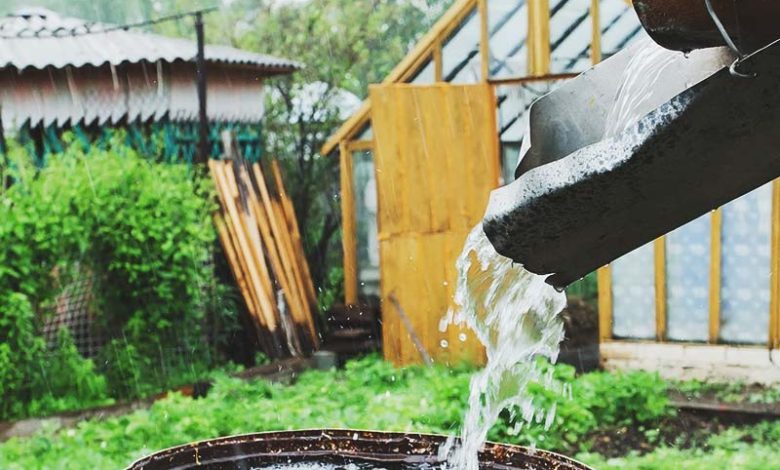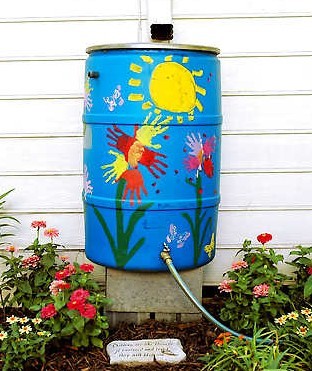How to collect rainwater in the garden: Very simple

As we all know, water is a sensitive issue, so we must learn to use the water resources that we have. One way to make the most of them is to recover rainwater. In addition to being of great help in the orchard, the recovery of rainwater constitutes a fight against floods.

In urban areas, many soils are waterproofed, so that, in the event of heavy rains, the drains and rivers are not capable of absorbing such amounts of water and lead to flooding. Collecting rainwater from the roof helps to avoid them. Some time ago we talked about the Rain Gardens to avoid these problems, and today we present you another alternative: rainwater collectors. Here we go!
How to install a rainwater collector in the garden
Investing in a rainwater collector is worth it, as it is easy for its cost to be amortized after the first irrigation season. Here are some clues about its installation:
- Install the rainwater collector in the gutter closest to the orchard, thus minimizing the effort of transporting watering cans when watering.
- Prepare a base high enough on which to sit the collector to be able to place the watering cans at a lower level and facilitate their subsequent filling.
- If you cut the gutter, once the recuperator is filled it will overflow, wetting the surrounding land, so it is better to drill it in such a way that it allows the gutter to function normally, that is, that the water reaches the sewage network when the collector is full.
- If the recuperator does not have a tap, install one at the lowest possible level so that the tank can be completely or almost completely emptied.
- Depending on the configuration and space of your garden, install one large recuperator or two or three smaller ones. You can distribute them in different gutters or place them all in the same gutter so that they empty into each other by gravity: the excess water from the highest collector will fall into the next level and the same will happen with the rest of the levels. You do not need to raise the containers to different heights, it is enough that the first one is higher than the second and this one higher than the third.
- If you bury the tank, it will be invisible, and in addition, it will be protected from light, preventing the development of algae or moss and allowing the water to remain fresh; however, you will need a pumping system to remove the water, although it does not necessarily have to be electric, as there are manual pumping systems.
As is logical, the more rainwater you have, the greater autonomy you will have with respect to the supply network. To give you an idea, with 1 cubic meter of reused rainwater, you can irrigate a plot of about 40 square meters in a temperate climate, and about 20 square meters in a hot climate. Are you really thinking about it?
How to use rainwater collectors
- If the collector is dry, for example, after the summer, fill it with water from the network, and from there your watering cans. In this way, you will prevent dirt from accumulating during times of drought and, in addition, you will be able to get an idea of the water you are using, since you will always have the reference of the capacity of the collector, while if you water directly from a hose you will have this perception it is much more complicated and we tend to waste water.

Clay vessel, very aesthetic to be used as a rainwater collector (Source: Estudioduqueyzamora.com) - If the water turns green, it is because it is filled with algae and moss, in this case, fill three quarters of the collector with water and pour half a liter of chlorine per cubic meter. Mix it with a stick or stick. You must wait three days to use it as irrigation water, time necessary for most of the chlorine to evaporate and not cause any damage to our crops.
- Keep the containers closed to prevent dry leaves and other materials from falling into the water, as they rot and can lead to bad odors and clogging. In the same way, it is important that the gutter is equipped with a grid to retain dead leaves. In addition, you will need to clean this grid regularly, especially during the fall.
Recycled rainwater collector
A rainwater collector is nothing more than a tank that collects precipitation normally through the roof gutter, as it is the simplest way. As you can imagine, you can use an infinite number of containers as collectors, so here are some of them:
- Casks and barrels of wine: You will not find it difficult to get them in wine regions at a good price. They also come ready to install a tap.
- Old garbage cans: Both plastic and metal will serve as rainwater collectors.
- Plastic containers from different industries: Once cleaned, they are very good because they have foolproof strength.
- Old fuel tanks: They will need a deep cleaning to convert them into water tanks.
Of course, you can give free rein to your imagination and decorate them to your liking, as we do with our Flower Pot.

So far our advice to recover rainwater. I hope they will be of great help to you in your garden. Until next time!

![Photo of Hostas: [Care, Planting, Irrigation, Substrate and Possible Problems]](https://www.complete-gardening.com/wp-content/uploads/2022/08/hostas-care-planting-irrigation-substrate-and-possible-problems-390x220.jpg)

![Photo of Brown Spots on Leaves: [Detection, Causes and Treatment]](https://www.complete-gardening.com/wp-content/uploads/2022/08/brown-spots-on-leaves-detection-causes-and-treatment-390x220.jpg)
